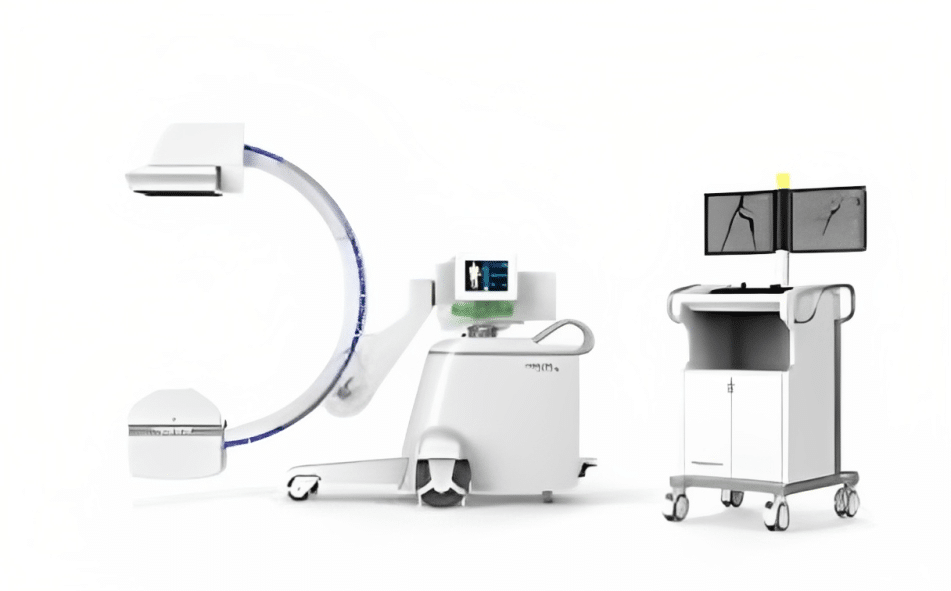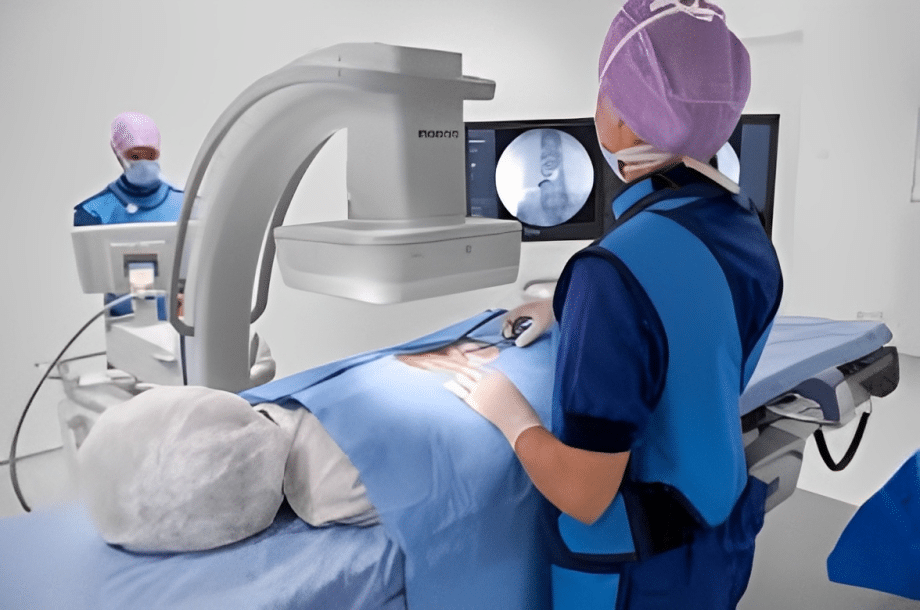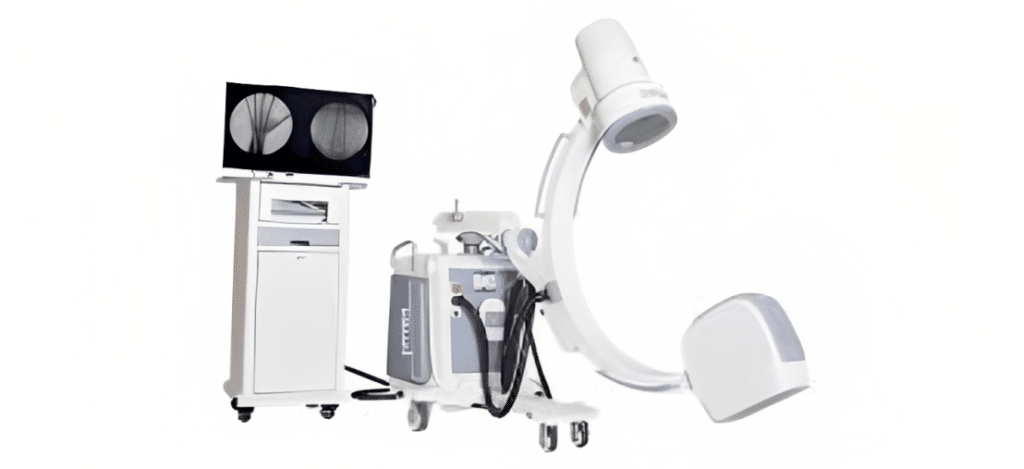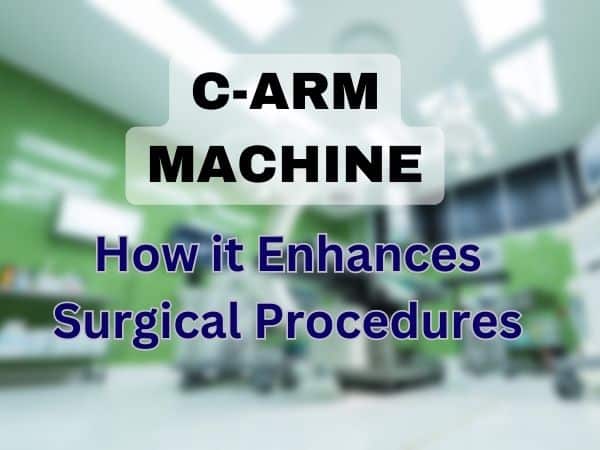C Arm Machine

C Arm Machine is a medical imaging device that uses X-rays to produce real-time images of the internal structures of the body. It is widely used in various surgical procedures, such as orthopedics, vascular, urology, neurology, cardiology, and pain management.
C Arm Machine consists of two main parts: a C-shaped arm that holds an X-ray source and a detector, and a monitor that displays the images. The C-shaped arm can be rotated around the patient to obtain different views and angles. The monitor can be placed near the surgeon or in a separate control room.
C Arm Machine is also known as a fluoroscopy machine or image intensifier. It is different from a conventional X-ray machine in that it can produce continuous images rather than static ones. This allows the surgeon to see the movement of organs, blood vessels, bones, implants, instruments, and contrast agents in real-time.
Benefits of C Arm Machine

C Arm Machine has many benefits for both patients and surgeons. Some of the benefits are:
- Improved accuracy and safety: C-Arm allows the surgeon to see the anatomy and pathology of the patient clearly and precisely. This helps to avoid damage to vital structures, reduce complications, and ensure proper placement of implants and instruments.
- Reduced radiation exposure: C-Arm uses lower doses of radiation than conventional X-ray machines. It also has features such as pulse fluoroscopy, collimation, and dose control that help to minimize radiation exposure to the patient, surgeon, and staff.
- Faster and easier procedures: C-Arm enables the surgeon to perform complex and minimally invasive procedures with less time and effort. It also reduces the need for multiple exposures or repositioning of the patient or the device.
- Better outcomes and recovery: C-Arm can improve the quality and effectiveness of the surgery. It can reduce blood loss, infection, pain, scarring, and hospital stay. It can also enhance the functionality and durability of the implants and instruments.
Demerits of C Arm Machine

C-Arm also has some demerits that need to be considered. Some of the demerits are:
- High cost: C-Arm is an expensive device that requires maintenance and calibration. It also consumes a lot of electricity and space. The cost of a C-Arm may vary depending on the type, size, features, and brand of the device.
- Limited field of view: C-Arm has a small detector area that limits the field of view. It may not be able to capture large or deep structures or organs. It may also have difficulty in imaging obese or metal-containing patients.
- Image quality: C-Arm may not produce high-quality images as compared to other imaging modalities such as CT scans or MRIs. It may have issues such as noise, distortion, artifacts, or blurring. It may also be affected by external factors such as temperature, humidity, or magnetic fields.
- Radiation risk: C-Arm still involves exposure to ionizing radiation that can cause harm to the patient, surgeon, and staff. The risk depends on the duration, frequency, intensity, and distance of the exposure. The effects of radiation may include skin burns, cataracts, cancer, or genetic mutations.
Types of C Arm Machines
The types of C arms are:
- Mini C arm: A small and portable C arm that is used for imaging the extremities, such as the hands, feet, ankles, knees, elbows, and shoulders. It has a 6″ or 9″ image intensifier and features like pulse fluoroscopy, image enhancement, and dose control. It is suitable for clinics that specialize in sports medicine, orthopedics, or podiatry.
- Compact C arm: A medium-sized C arm that is used for general imaging and can fit in smaller spaces. It has a 9″ image intensifier and features like pulse fluoroscopy, image enhancement, and dose control. It is suitable for hospitals or ambulatory surgery centers that perform various procedures such as orthopedics, urology, or pain management.
- Full-size C arm: A large C arm that is used for complex procedures and offers more power and versatility. It has a 9″ or 12″ image intensifier or a flat panel detector and features like pulse fluoroscopy, image enhancement, dose control, and 3D imaging. It is suitable for hospitals or trauma centers that perform advanced procedures such as vascular, neurology, cardiology, or spine surgery.
- Super C arm: A C arm with a larger arc that provides more coverage and flexibility. It has a 16″ or 21″ flat panel detector and features like pulse fluoroscopy, image enhancement, dose control, 3D imaging, and a navigation system. It is suitable for hospitals or hybrid ORs that perform highly specialized procedures such as endovascular robotics or orthopedic revision surgery.
C Arm Machine Price
| Type | Size | Features | Brand | Condition | Price Range (USD) |
|---|---|---|---|---|---|
| Mini C Arm | 6″ or 9″ image intensifier | Pulse fluoroscopy, image enhancement, dose control | GE OEC 6600, Hologic Fluoroscan Insight-FD | New or refurbished | 9,700 to 18,200 |
| Compact C Arm | 9″ image intensifier | Pulse fluoroscopy, image enhancement, dose control | Siemens Siremobil Compact L, Allengers HF 49 R Plus | New or refurbished | 12,200 to 24,300 |
| Full-size C Arm | 9″ or 12″ image intensifier or flat panel detector | Pulse fluoroscopy, image enhancement, dose control, 3D imaging | Philips BV Pulsera, GE OEC 9800 Plus, Siemens Arcadis Varic, Ziehm Vision RFD Hybrid Edition | New or refurbished | 18,200 to 48,600 |
| Super C Arm | 16″ or 21″ flat panel detector | Pulse fluoroscopy, image enhancement, dose control, 3D imaging, navigation system | Siemens Cios Alpha, GE OEC Elite CFD Premium Mobile C-Arm System | New or refurbished | 48,600 to 97,200 |
The prices are indicative and may change depending on the availability and demand of the devices. It is advisable to compare the prices from different suppliers and negotiate the best deal before buying a C Arm Machine.
Conclusion
C Arm Machine is a useful medical imaging device that can provide real-time images of the internal structures of the body during surgery. It has many benefits such as improved accuracy, reduced radiation exposure, faster procedures, and better outcomes. However, it also has some demerits such as high cost, limited field of view, image quality issues, and radiation risk. Therefore, it is important to weigh the pros and cons of C-Arm before using it for any surgical procedure.
References
(1) Mini C-Arm Advantages & Disadvantages – C Arms – New, Used, and Rentals.
(2) Advantages and Disadvantages of ARM processor – GeeksforGeeks.
(3) ARM Explained: Advantages and Disadvantages – Profolus.
FAQs
What is C Arm Machine and how does it work?
C-Arm is a medical imaging device that uses X-rays to produce real-time images of the internal structures of the body during surgery. It consists of a C-shaped arm that holds an X-ray source and a detector and a monitor that displays the images.
What are the benefits of the C Arm Machine?
C-Arm has many benefits such as improved accuracy, reduced radiation exposure, faster procedures, and better outcomes. It allows the surgeon to see the anatomy and pathology of the patient clearly and precisely, and to perform complex and minimally invasive procedures with less time and effort.
What are the demerits of the C Arm Machine?
C-Arm also has some demerits such as high cost, limited field of view, image quality issues, and radiation risk. It is an expensive device that requires maintenance and calibration, and it may not be able to capture large or deep structures or organs. It also involves exposure to ionizing radiation that can cause harm to the patient, surgeon, and staff.
How is C Arm Machine different from a conventional X-ray machine?
C-Arm is different from a conventional X-ray machine in that it can produce continuous images rather than static ones. This allows the surgeon to see the movement of organs, blood vessels, bones, implants, instruments, and contrast agents in real-time. It also uses lower doses of radiation than conventional X-ray machines.
What are the types, sizes, features, and brands of C Arm Machines?
C-Arm can be classified into different types based on the size and shape of the C-shaped arm, such as mini C-Arm, compact C-Arm, full-size C-Arm, or super C-Arm. It can also have different features such as pulse fluoroscopy, collimation, dose control, image enhancement, or 3D imaging. Some of the popular brands of C-Arm are GE Healthcare, Philips Healthcare, Siemens Healthineers, Ziehm Imaging, and Hologic.
